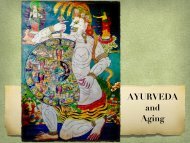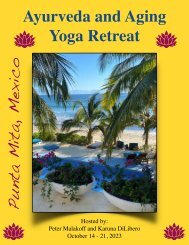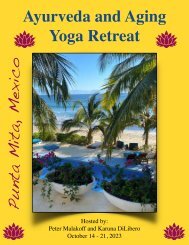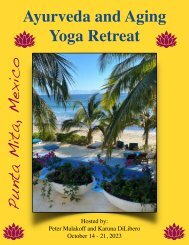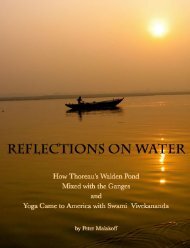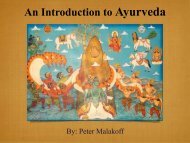How Thoreau's Walden Pond Mixed with the Ganges and Yoga Came to America with Swami Vivekananda
One early morning in 1846, during the coldest days of a New England winter, Henry David Thoreau looked out the window of his small cabin on Walden Pond and saw men cutting its ice into blocks. That ice was hauled by horse to a railroad that ran across the western edge of Walden Pond, packed into a boxcar, taken to Boston and loaded onto a clipper ship that sailed to Calcutta, India, arriving about four months later. Once there, that ice was purchased by grateful members of the East India Company. Thoreau had witnessed a small part of the global ice trade between New England and India that took place during the latter part of the nineteenth century. When Thoreau considered the ice trade, his vision sailed on metaphors far beyond the scope of business. The waters he imagined flowed both east and west and carried not just natural elements, but culture, religion and philosophy as well. He envisioned that after arriving in Calcutta, the New England ice of Walden Pond would eventually melt and run downhill where it would join with the sacred water of the Ganges. He wrote in Walden: "It appears that the sweltering inhabitants of Charleston and New Orleans, of Madras and Bombay and , drink at my well. In the morning I bathe my intellect in the stupendous and cosmogonal philosophy of the , since whose composition years of the gods have elapsed, and in comparison with which our modern world and its literature seem puny and trivial; and I doubt if that philosophy is not to be referred to a previous state of existence, so remote is its sublimity from our conceptions. I lay down the book [Bhagavad-Gita] and go to my well for water, and lo! there I meet the servant of the Bramin, priest of and and who still sits in his temple on the Ganges reading the , or dwells at the root of a tree with his crust and water jug. I meet his servant come to draw water for his master, and our buckets as it were grate together in the same well. The pure Walden water is mingled with the sacred water of the Ganges." This book tells the story of these waters . . .
One early morning in 1846, during the coldest days of a New England winter, Henry David Thoreau looked out the window of his small cabin on Walden Pond and saw men cutting its ice into blocks. That ice was hauled by horse to a railroad that ran across the western edge of Walden Pond, packed into a boxcar, taken to Boston and loaded onto a clipper ship that sailed to Calcutta, India, arriving about four months later. Once there, that ice was purchased by grateful members of the East India Company. Thoreau had witnessed a small part of the global ice trade between New England and India that took place during the latter part of the nineteenth century.
When Thoreau considered the ice trade, his vision sailed on metaphors far beyond the scope of business. The waters he imagined flowed both east and west and carried not just natural elements, but culture, religion and philosophy as well. He envisioned that after arriving in Calcutta, the New England ice of Walden Pond would eventually melt and run downhill where it would join with the sacred water of the Ganges. He wrote in Walden: "It appears that the sweltering inhabitants of Charleston and New Orleans, of Madras and Bombay and , drink at my well. In the morning I bathe my intellect in the stupendous and cosmogonal philosophy of the , since whose composition years of the gods have elapsed, and in comparison with which our modern world and its literature seem puny and trivial; and I doubt if that philosophy is not to be referred to a previous state of existence, so remote is its sublimity from our conceptions.
I lay down the book [Bhagavad-Gita] and go to my well for water, and lo! there I meet the servant of the Bramin, priest of and and who still sits in his temple on the Ganges reading the , or dwells at the root of a tree with his crust and water jug. I meet his servant come to draw water for his master, and our buckets as it were grate together in the same well. The pure Walden water is mingled with the sacred water of the Ganges."
This book tells the story of these waters . . .
You also want an ePaper? Increase the reach of your titles
YUMPU automatically turns print PDFs into web optimized ePapers that Google loves.
him a spring of water welling up <strong>to</strong> eternal life.” The woman said <strong>to</strong> him, “Sir,<br />
give me this water, so that I will not be thirsty or have <strong>to</strong> come here <strong>to</strong> draw<br />
water.”<br />
In <strong>the</strong> s<strong>to</strong>ry of this book, I refer <strong>to</strong> Ramakrishna <strong>and</strong> Vivekan<strong>and</strong>a as<br />
Spiritual Masters or Realizers. They were bearers of Living Water <strong>and</strong> that is<br />
why I make particular reference <strong>to</strong> <strong>the</strong>m; I am pointing <strong>to</strong> a special class of<br />
beings who carry Living Water <strong>and</strong> offer it <strong>to</strong> o<strong>the</strong>rs. It is <strong>the</strong> bearers of Living<br />
Water who refresh <strong>the</strong> thinking <strong>and</strong> culture in<strong>to</strong> which <strong>the</strong>y are born, often in<br />
<strong>the</strong> process creating new religions or new traditions <strong>with</strong>in older ones that<br />
have dried up. The Indian scriptures not only recognize such beings, <strong>the</strong>y<br />
distinguish differences amongst <strong>the</strong>m as well. All do not perform <strong>the</strong> same<br />
function or even have <strong>the</strong> same Realization. Some are saints, some sages,<br />
some siddhas <strong>and</strong> some are Avatars. What I suggest here is that in one way<br />
or ano<strong>the</strong>r, <strong>the</strong>re is something special about <strong>the</strong>se people <strong>and</strong> I use <strong>the</strong> term,<br />
“Realizer” <strong>to</strong> indicate this particular class of beings.<br />
Throughout his<strong>to</strong>ry, it has been <strong>the</strong> function of <strong>the</strong> greatest Spiritual<br />
Masters <strong>to</strong> bring what is called in <strong>the</strong> Bible “Living Water.” Whe<strong>the</strong>r it is <strong>the</strong><br />
underst<strong>and</strong>ing of life, <strong>the</strong> meaning of a scripture, or <strong>the</strong> transmission of<br />
spirit, “Living Water” is <strong>the</strong> essence of religion.<br />
Those who follow <strong>the</strong> rules of established rituals <strong>to</strong> <strong>the</strong> letter are called <strong>the</strong><br />
"orthodox." They tend <strong>to</strong> take over established religious organizations <strong>and</strong><br />
define what it is <strong>to</strong> be a "true" devotee, practitioner or believer. Jesus<br />
summarized <strong>the</strong>ir liability this way: They follow <strong>the</strong> letter of <strong>the</strong> law but have<br />
lost <strong>the</strong> spirit. It is spirit that is <strong>the</strong> source <strong>and</strong> subject of religion. I refer <strong>to</strong><br />
spirit here as <strong>the</strong> “Living Water” of life.<br />
This is why it is necessary that living God-men, true Realizers, come <strong>to</strong><br />
revitalize <strong>and</strong> interpret religious traditions, age after age, pouring out <strong>the</strong><br />
Living Water of Realization <strong>and</strong> purifying <strong>the</strong> stagnant pools of laws <strong>and</strong><br />
beliefs. This is what Jesus did for Judaism. Jesus was a Jew, yet he criticized<br />
80







